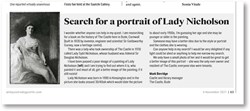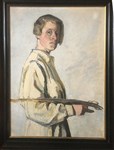I recently bought two lots, one from a south-west England saleroom and one from a northern saleroom. The two lots were shipped (one from the former and one from the latter).
Charges to be paid
The one sent from the south-west was delivered as normal with no extra charges, while that from the north had been opened and a charge of customs tax and clearance charges amounting to 37% of the hammer price applied, to be paid on delivery.
The package sent from south-west had attached a ‘Commercial Invoice’ which included a description of the lot as ‘antique decorative candlesticks’ and a Tariff Code 9706.000060. It appears this is a standard practice for their overseas buyers.
The package from the north included a copy of the standard auction house’s invoice containing the description from the catalogue, which contained no mention of ‘antique’ or ‘tariff code’.
It appears that the south-western saleroom has its own very effective standard practice for items bought by overseas customers.
It would be very helpful if you could clarify the current position post Brexit regarding ‘antiques’ and tariff codes.
Name supplied
ATG asked fine art shipping company Convelio for an expert’s view on this letter. Jasmine Ramsay Gray, head of operations UK, sent this reply:

Jasmine Ramsay Gray, head of operations UK at Convelio.
Prior to Brexit, customers resident in Europe were not required to pay any duties or taxes on purchases from UK vendors and vice versa.
Since Brexit and the ending of this frictionless system, there are more costs involved and administration required for businesses selling between the UK and EU. Businesses and customers located in EU countries need to ensure that these costs are understood so that there are no delays or unexpected payments to be made during the customs process.
All items must be shipped with a full commercial invoice that explains to customs officials what is being imported, including the type of object, its age, production origin and materials from which it is made.
A tariff code is an internationally used abbreviation that explains to customs officials quickly what the item is; the correct tariff code must be used to ensure that the correct charges are paid by the importer.
A tariff code starting with 9706 is used to designate items which are considered ‘antique’, and in the eyes of the law, this must be over 100 years old.
Sometimes, a written and signed statement is also provided by the vendor to testify that the item is over 100 years old. Items declared as ‘antiques’ in this way can then have a lower rate of import taxes.
It may be more time-consuming for businesses to create more paperwork to accompany their shipments going between the UK and EU, and to search for the correct tariff code, but items which are missing documents or are labelled with an incorrect tariff code risk being held up in customs, or even returned to the seller. It is important that this administration is completed correctly.














